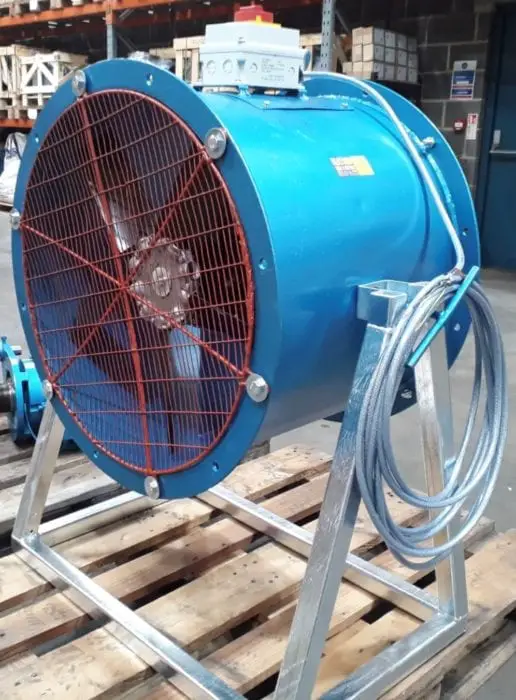Industrial fans as the name suggest move a lot of air at once to cool down large machinery. It is not therefore surprising that they sometimes make a lot of noise.
This could be the reason why you are looking for how to make an industrial fan quiet for you and those who are working under such fans for long hours at a time.
The good news is that you can employ some fan noise reduction techniques in this article to successfully reduce the noise.

How Loud are Industrial Fans?
An industrial fan is a high efficient, heavy-duty airflow device that is constructed from highly durable materials and components.
This makes them able to withstand harsh environmental conditions and operate longer to provide constant airflow and pressure to cool down systems.
Industrial fans are stronger because of the materials used to manufacture them and these include; roller bearings, continuous welds, and housings made of cast aluminum and stainless steel.
These devices are pretty loud. It is generally required that manufacturers should keep these fans’ noise levels below 85 decibels at five feet away for an eight-hour shift.
With that in mind, you will find industrial fans often have noise levels either at or below this specified noise level. Even at that, some people will still find these fans still louder depending on the speed, size, type of fan, and the perception of the listener.
That is why it may be necessary for you to implement some fan noise reduction techniques to help maintain a comfortable and safe working environment.
Also Read:
Effective ways to make an inline fan quieter
How to Achieve Industrial Fan Noise Reduction
There are a couple of fan noise reduction techniques you can implement on industrial fans to keep the noise levels low for a comfortable working environment.
1). Use an Industrial Fan Silencer to Close the Inlet/or Outlet
When looking for ways to reduce industrial fan noise, some of the best places are the inlet and outlets of the fan. Generally, industrial fans have either ducted inlet, outlet, or both.
Whichever one that your fan has, you can reduce the noise by putting an industrial fan silencer in it.
In some rare cases, it’s possible to put the silencer between the fan and the ductwork. Fan silencers work in a similar way to a car muffler, which extends the muffled sound.
2). Block Fan Motor Noise
Fan motors are also another source of noise from the fan. Generally, industrial fan motors are designed to operate below the standard 85 dB at 5 feet as required.
However, you may be required to lower this noise level depending on your application. If you have already tackled the inlet. outlet or both sides of the fan and yet still get high noise levels, then it would be wise to check the fan motor.
To reduce the fan motor noise, you may need to build a sound enclosure to house the entire fan. This will further reduce the entire fan noise.
3). Reduce Radiant Noise
If after implementing both techniques and you still need further noise reduction, the next is to tackle the radiant noise. This noise is the kind that has penetrated the housing surrounding the fan.
There are two notable ways of reducing radiant noise; these are increasing the thickness of the housing and sound insulation.
If it’s just a small noise reduction you want, then increasing the thickness of the housing is going to take care of that.
However, for substantial noise reduction, you will need to opt for a sound insulation jacket.
Industrial Fan Insulation Types and Considerations
The insulation that surrounds industrial fans serves the dual purpose of thermal and sound protection. It also creates a sheath around the fan that requires access in order to maintain or repair the fan.
There are different fan insulations available for different applications.
Types of Fan Insulations
There are three main insulation types of insulations that provide thermal and or sound protection in industrial applications. These are; removable insulation jackets, cladding, and double-walled insulation housing.
Removable insulation jacket
The removable insulation jacket is user-friendly and is suitable for those who need frequent and easy access to the fan for maintenance.
Generally, they are installed in panels that are held in place with 10 gauge wires. They are user-friendly because one panel covers the fan access door giving you quick access to the fan wheel for maintenance and inspection.
Double Walled Insulation Housing
This insulation maintains the look of the fan with a layer of painted carbon steel serving as an exterior that also surrounds the insulation.
Cladding
This type of insulation is often made of various materials but often is made of aluminum. It gives a more integrated and cleaner look.
Cladding covers the insulation and it is fastened down by either screws or rivets. They open it up for maintenance is challenging and will require you to remove the screws or the rivets.
You will also need to do some caulking after you have put it together to maintain its thermal and acoustic qualities.
Final Thoughts on How to Make an Industrial Fan Quiet
The noise originating from industrial fans because of the moving parts can cause a lot of discomfort to workers in the workplace.
As stated above, you can achieve noise reduction by using a fan silencer on the inlet, outlet, or both sides to reduce the noise. By creating housing for the fan and lastly by insulating with a sound insulation jacket.
These are some of the ways to reduce industrial fan for a peaceful and comfortable working environment.
- How to Chew Quietly While Eating-Effective Tips - April 14, 2023
- Why is My Clutch Pedal Squeaking – Causes & Fixes - April 14, 2023
- Propane Tank Making Hissing Noise (Solved) - February 25, 2023
